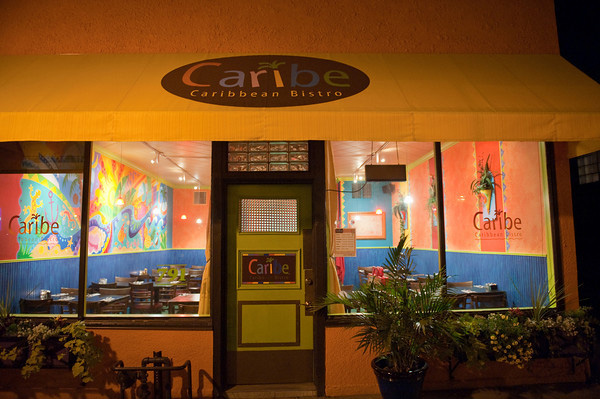
They’re patacones from Panama to Peru; Haitians call them bananes pesées, and in the Dominican Republic, they’re casually referred to as fritos. But in much of Latin America and the Caribbean, they’re known as tostones, and that’s how you’ll find them on menus across our own Twin Cities. Regardless of its varied nomenclature, the dish can be described simply and invariably as “twice-fried green plantains.”
Especially popular in Puerto Rico, Cuba, and the Dominican Republic, tostones in their most essential form are products of a mere three ingredients: plantains, oil, and salt. The plantains are sliced and fried, then flattened and fried again. Classic preparation enlists a tostonera, a plantain press that produces perfectly rounded and uniform coins. Even without such a handy tool, the process is simple, especially to someone who has been doing it a while. Tony Panelli, chef and co-owner of Caribe in St. Paul, laughed after describing the rather humdrum procedure. “It’s not really an art.”

Having spent the first decade of his life in Puerto Rico, Panelli has been making and eating tostones since he was a kid. Now they’re a constant on his menu. He may be weary of the things, but he still knows what he wants in tostones: They should be thin, crispy, and made with very green plantains.
Most chefs would agree with that last part. It’s the green plantains that make tostones, tostones. The unripe fruit is strong enough to withstand the frying, smashing, and frying, and it accounts for the starchiness that defines the dish. So what do chefs do when black specks, the harbingers of ripeness, begin to appear on their plantains? Some may stop selling tostones altogether. Brasa has adopted this practice, switching over to fried sweet plantains until the next green batch comes in. Most establishments, however, must work with what they have. That means the same restaurant may serve tostones of variable sweetness and starchiness, depending on the day.
So maybe tostones aren’t as straightforward as we’d think. As chefs contend with the processes of nature, they can rely on myriad toppings and dipping sauces to create a wholly unique taste experience. Though they must be able to hold their own unadorned, tostones offer a blank canvas and potential for a masterpiece. A recent search for local tostones found three renditions born from three very different approaches.

Authenticity at Your Own Risk: Victor’s 1959 Cafe
“Tostones with house mojo” ($4.75)
We felt that these failed on all counts. They looked interesting enough, the lightly golden hue of the tostones scattered with green onion and globs of the jellylike house mojo. It wasn’t pretty, but with the merits of ugly food in mind, we dove in. The mojo instantly overpowered everything in its wake. According to Victor’s, it contained onion, garlic, and lime — the makings of a genuine Cuban mojo. This sauce is characteristically acidic, sometimes made with vinegar in addition to lemon or lime juice. The Victor’s version may have been authentic Cuban, but it was much too astringent for my “yanqui” palate.
Unfortunately, the tostones sans mojo didn’t shine either. They were chalky and devoid of salt and crunch. Enthusiasm of any kind was not to be found in my party of six, and after the plate circulated twice among us, one sad little tostone remained.

Simply Irresistible: El Meson
“Tostones with a classic Puerto Rican sauce and an avocado mojo sauce” ($5 happy hour item / $4.50 side item)
The small plate that arrived at our table held a handful (at most) of perfectly golden rounds topped with nothing more than visible bits of coarse salt.
Dolloped on the plate itself were the two dipping sauces, each an earthy tropical hue. The tostones were thin and crispy with a nice give in the center and a beautiful crunch around the edges. They were not at all chalky, or even overly starchy. There might have been, in fact, the slightest trace of sweetness.
The sauces were adequate to the job at hand. The Puerto Rican sauce smacked of a mayo-ketchup combo, and after a while, it became difficult to distinguish from the avocado mojo. That being said, the matchup was still good. So good, in fact, that one plate may not be enough (and chances are, if you ask for more tostones, you’ll want another sangria to go with it).
Note: Brasa turns out comparable tostones that come with a mayo-based dipping sauce with clear notes of cilantro, citrus, and ginger. It’s nice to look at, and a refreshing break from all that garlic. Which brings us to…

Refreshing on All Counts: Caribe
“Tostones with avocado and Puerto Rican mojito” ($6)
We sensed that we’d found something different before we even took the first bite.
For starters, the tostones arrived in single file on a long, narrow plate. The Puerto Rican mojito sat dead center, like an impassive sentry that silently marks the boundary between your date’s tostones and your own. These tostones were thinner than the others, and atop each bright golden disc was a swipe of fresh avocado. They were the least starchy of the lot (although that may not be the case on a different day); we noted a muted sweetness and creamy interior.
Still, the edges were crisp and the exterior salted, which wouldn’t have been anything new were it not hobnobbing with the cool, creamy avocado. That simple topping was a coup for this dish, one that chef Tony Panelli discovered when visiting relatives in Puerto Rico. Panelli took the dish one step further with the Puerto Rican mojito, a composite of everything you’d find in salsa, plus a couple additions — like capers and oregano — that make it stand out. It was a clean departure from the mayo-based sauces, and a perfect accompaniment to those last crispy edges. Tostones to start, chips and salsa to finish; it’s a whole that is greater than the sum of its parts.
You might even call it a work of art.

My wife loves the ones from Brasa St Paul (they aren’t on the menu anymore, but you can usually get them).
Sunstreet Bread’s tostones (on the dinner menu) are lovely! As is everything else there.
No Chimborazo? Next time skip Victor’s and head NE for the real deal.
I have purchased frozen tostones from Sam’s club in Ponce, PR & cooked them myself. These were better than most u can get within the twin cities. Sad.
I agree with Alexis. Chimborazo has great tostones.
Why, oh why, do Caribe and El Meson keep getting high marks for reviews? I have eaten at El Meson on and off for over 20 years and never have a very good meal there. Maybe chicken valencia. MAYBE. But that’s it. Thoroughly mediocre to downright bad. I have always wanted to like it. And as for Caribe? Nothing we have ever eaten there is any good. We have tried several times, because of the reviews, but I have had fish that was quite literally spoiled, flavorless and blah badly cooked dishes. As for Brasa and Chimborazo? That’s what I’m talking about!
The tostones at Sun Street Breads are heavenly and the best so far in the Twin Cities. Crispy, salty & served with a side of Pineapple Mojo…yum!